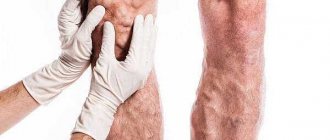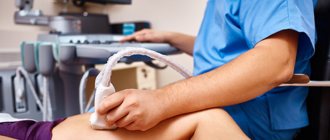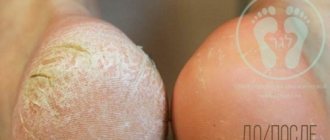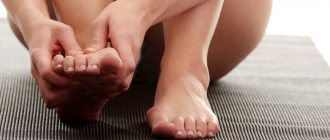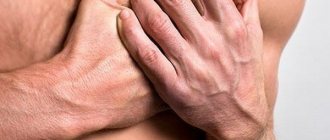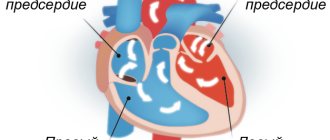Heaviness in the legs is a familiar feeling to many people, regardless of gender, age and type of activity. Heaviness in the legs is a subjective characteristic of such manifestations as: discomfort and a feeling of heaviness in the legs, a feeling of fullness and nagging pain in the calf muscles, swelling.
This feeling may be experienced by:
- children and young people who are in a period of active growth of the musculoskeletal system,
- elderly people and old people,
- athletes after long training sessions,
- pregnant women,
- overweight people.
Very often, heaviness in the legs bothers people whose profession involves heavy physical exertion and heavy lifting, staying in one position for a long time, sitting or standing, for example, office workers, doctors, teachers, drivers, and so on.
Heaviness in the legs can be a transient condition: the discomfort disappears after a night's rest, massaging the legs, a contrast shower, a short stay in the “legs above the body” position, or permanent. Regular complaints of heaviness in the legs are an “alarm bell” signaling problem veins and a serious reason to consult a phlebologist. Diagnosis of venous insufficiency at an early stage, individually selected therapy, carried out under the supervision of a specialist, is the only way to avoid further development of varicose veins.
Reasons for pulling legs
The most common cause of pain and so-called heaviness in the calf or thigh area is problems with the spine. For example, it may be a disease that subsequently causes heaviness and pain.
These unpleasant symptoms are explained by the fact that a pinched nerve occurs, which is accompanied by specific nagging pain in the lumbar region and calves. This kind of painful symptomatology can bother you both during the day and at night. To identify the disorders that lead to them, as well as to eliminate them, a tomographic examination of the spine is necessary.
pulling legs - painful sensations in the calves
Foot problems can be caused by many things. For example, these include muscle strain, varicose veins, atherosclerosis, gout, some diseases of the genitourinary system, diabetes, rheumatism and even intoxication of the body.
Some of the listed ailments directly affect the free circulation of blood in the body and, in particular, in the legs, as they directly affect the thickness of the walls of blood vessels. This is why unpleasant symptoms and nagging pain in the legs .
Diagnostics
Considering that most cases of heaviness in the legs are associated with venous circulation disorders, an examination by a phlebologist is necessary. Often, a preliminary diagnosis is made during an objective examination, when varicose veins, edema, hyperpigmentation, and other typical manifestations are detected. To clarify the diagnosis and identify other etiological factors causing heaviness in the limbs, the following is carried out:
- Doppler ultrasound of veins
Duplex scanning of vessels is used to study the anatomical structure of the venous bed, assess the tone and function of the valves. Chronic venous insufficiency is manifested by slow blood flow, pathological blood reflux, and phlebothrombosis. - Rheovasography of the lower extremities.
A modern diagnostic method that shows even minor changes in hemodynamics and microcirculation. Based on the results of the study, the doctor gives an opinion on the condition of the peripheral veins during stress tests and at rest. Sometimes venography is prescribed for additional examination of blood vessels. - Lymphangiography.
Visualization of lymphatic vessels using a contrast agent is required to determine their patency and the functioning of the valve apparatus. The difference in diameter in different parts of the vessels and uneven contrast indicate pathology. For dynamic assessment of lymph circulation, lymphoscintigraphy is indicated. - X-ray of the foot.
If flat feet are suspected, an orthopedic traumatologist joins the diagnostic search. Based on X-ray images, the doctor measures the height of the arches and pathological angles between bone structures, establishes the type and severity of the disease. The diagnosis is clarified using plantography. - Additional research
. To diagnose osteochondrosis, which causes heaviness in the legs, an x-ray or computed tomography scan of the spine is performed. To confirm cardiac diseases, ECG, echocardiography, and chest X-ray are recommended. Survey and excretory urography are informative for excluding renal causes of edema.
Phlebologist consultation
Role of the vascular system
An important factor is the slagging of the body, in particular the vascular system. Due to accumulated deposits on the walls of blood vessels, blood circulation is significantly impaired. As a result, an already serious problem is aggravated, since the removal of metabolic products slows down.
The main reasons that cause nagging pain in the legs and discomfort when moving in the calves can only be determined by a specialized specialist (vascular surgeon), who will prescribe a special set of scanning procedures and tests (blood for coagulation indicators, glucose, platelets).
When can leg weakness be dangerous?
If the symptom is accompanied by a feeling of “woolly legs” and this does not occur in extreme heat, not from overwork or starvation, we can assume more serious causes - a pre-heart attack and pre-stroke condition. In parallel with the weak legs, heart pain or headache appears, and the fingers go numb. Here the minutes are counting.
Sometimes the cause of weakness in the legs is anemia - a deficiency of vitamin B12. This symptom is especially dangerous in older age. How to proceed in this case?
Types of nagging leg pain
- Quite sharp and sharp pain in the ankle and calf area, which may be accompanied by muscle numbness, indicates the initial symptoms of atherosclerosis. Confirmation is the disappearance of unpleasant sensations after a short rest, which return after a certain period of time. There are also frequent cases when the problem bothers a person even at rest. In order to get rid of pain in the calves and thighs, you should give up bad habits. As a rule, diagnostic measures are carried out using ultrasound, after which treatment (vascular plastic surgery) is prescribed.
- An acute painful reaction to movement, constricting the muscles of a limb or thigh with a spasm. Feet can be cold even during the warm season. It is also possible such a phenomenon as the absence of a clear pulsation on the big toe of the lower limb and its pain. The listed symptoms may indicate the presence of a disease such as endarteritis. To eliminate the disease, you should contact a specialist who can quickly identify its causes. If signs of the disease appear in a smoker, you should give up this addiction. If the pain is too acute and the leg muscles are cramping, it is better to call an ambulance, as inaction can lead to blockage of the arteries.
- You will need to consult a rheumatologist if you feel unpleasant sensations and pain in your joints and calves both while standing and while walking. These types of symptoms are characteristic of arthritis. To solve the problem, you will need to undergo the necessary tests, consult a specialist and x-ray examination. To restore health, you will need to take special medications in combination with regular physiotherapeutic procedures.
- As a rule, the calves can be bothersome during thrombophlebitis: the pain is characterized by its constancy, which after a while turns into a burning sensation. This disease is accompanied by symptoms such as compactions in the area of blood vessels, swelling and redness of the skin. Treatment is most often outpatient.
- Pain in a part of the body such as the hips is a concern if you have problems with the genitourinary system. To identify the cause that causes nagging pain, an ultrasound should be done.
- Quite often, the consequences of injuries or hip fractures cause pain or discomfort when moving. To eliminate such symptoms, orthoses specially manufactured for such purposes are used. This will also help relieve stress on your muscles.
- Convulsive contractions of the limbs during sleep, a feeling of weakness, swelling of the skin, as well as itching of the calf of one or the other leg can signal a disease such as diabetes. In this case, be sure to take the appropriate tests and visit a specialist who will prescribe all the necessary procedures.
- A sharp pain in the heel that extends to the calves may indicate a so-called “heel spur.” The solution to the problem is a consultation with an orthopedist and undergoing prescribed procedures with mandatory x-ray diagnostics. If a person is overweight, a change in eating behavior and nutritional system will be required.
calf leg massage
Treatment
Help before diagnosis
To get rid of heaviness in the legs, patients are advised to choose comfortable shoes and use orthopedic insoles. If you need to spend the whole day in a standing position (hairdressers, salespeople, cooks), you need to wear compression stockings that help reduce venous stagnation. It is necessary to maintain body weight within normal limits so as not to create additional stress on the feet.
To improve peripheral blood circulation and increase the tone of venous vessels, exercise (swimming, cycling) is useful. The amount of strength and static training, which increases the deposition of blood in the veins, should be reduced. Lifestyle changes play an important role: increasing daily activity, frequent walking.
Conservative therapy
Treatment of vein diseases in clinical phlebology begins with medications: taking antiplatelet agents, phlebotonics, applying ointments and creams to areas of the skin with trophic lesions. B vitamins and desensitizing drugs are indicated as general tonic agents. In rare cases, the treatment regimen is enhanced with corticosteroid hormones.
Therapy is supplemented with elastic compression (bandages, stockings) to maintain venous vessels in tone and reduce heaviness in the legs. For the treatment of varicose veins, compression sclerotherapy is widely practiced - the injection of drugs into the veins that cause gluing of the vascular walls and reduce venous stagnation. After the manipulation, pain and swelling of the legs are eliminated.
To reduce edema in cardiac and renal pathologies, diuretics are used. With constant use of the medicine, excess fluid is removed, shortness of breath and heaviness in the legs are eliminated. For heart failure, beta blockers, glycosides and other drugs are additionally prescribed to improve the strength of myocardial contractions.
Surgery
For varicose veins, several types of surgical interventions are performed:
- minimally invasive (photocoagulation, laser removal of spider veins, radiofrequency coagulation);
- classical (phlebectomy, Troyanov-Tredelenburg operation).
For patients with lymphedema, lymphovenous shunting, tunneling, and autotransplantation of the tissue lymphoid complex are recommended.
Flat feet are treated by experienced orthopedic traumatologists. In the stage of planovalgus foot, resection of protruding areas of bones, tendon transplantation, and removal of heel spurs are performed. For patients with severe transverse flatfoot, resection of hallux valgus followed by plastic surgery of the articular capsule is indicated.
What to do when your legs drag
A common reason that a person is bothered by unpleasant pain in the legs and calves, caused by muscle cramps (especially at night), may be a banal lack of essential microelements in the body for life. This can be observed in pregnant women (hips are more of a concern). As a rule, after a person begins to take a vitamin complex, problems disappear.
Let us note that modern medicine has stepped far forward, and currently there are tests that can reveal which microelement is missing in the body.
As an example, for symptoms such as painful limbs in the evening and at night, the treatment method is based on replenishing the body with the doses of magnesium it needs. That is, in order not to pull your left or right leg, you need a balanced diet.
To determine the exact cause and the correct treatment for nagging pain in the legs, you should first make an appointment with a doctor.
If pain and heaviness in the legs is associated with varicose veins, then treatment is necessary.
When treating varicose veins, compression sclerotherapy (phlebosclerosis), endovasal laser or radiofrequency obliteration and surgery are used. Indications for a particular technique are determined by a phlebologist, based on ultrasound scan data. The choice of treatment method primarily depends on the diameter of the varicose veins.
Sclerotherapy is carried out at the earliest stages of varicose veins. This is a non-surgical treatment method in which a sclerosant drug is injected into the affected vein using an ordinary syringe and needle, causing the cessation of blood flow in it, while the lumen of the vein becomes overgrown. With endovasal laser coagulation and radiofrequency obliteration, the same thing happens, but due to the thermal effect on the venous wall. Finally, during surgical treatment, the vein is removed.
Intoxication
Any poisoning or infection causes general poisoning of the body and failures in many systems. Even a common ARVI, not to mention a bacterial infection, is accompanied by general weakness. Sunstroke, harmful working conditions, stale food - everything can lead to weakness, and each reason needs to be dealt with. In many cases, long-term alcoholism is destructive to nerves and muscles.
CELT doctors, who have unique practical experience, will help to accurately determine the cause of the disease.
Make an appointment through the application or by calling +7 +7 We work every day:
- Monday—Friday: 8.00—20.00
- Saturday: 8.00–18.00
- Sunday is a day off
The nearest metro and MCC stations to the clinic:
- Highway of Enthusiasts or Perovo
- Partisan
- Enthusiast Highway
Driving directions
The most dangerous symptom
You should sound the alarm if weakness manifests itself not in both, but only in one leg, especially if one arm on the same side also goes numb. Very often this indicates a pre-stroke condition, when a vessel in the brain becomes blocked. You must call a doctor immediately.
Weakness in the left leg and loss or decrease in sensation indicate neurological pathology. In this case, you should also not hesitate, even if the symptoms are minor. Over time, the disease may develop into a tumor, disorders of the nervous system will worsen and lead to complications.
Weakness in one leg is a very alarming and dangerous symptom.
If you feel weakness in your legs that does not go away after rest and returns regularly, if it is also accompanied by pain or other symptoms of illness, do not attribute it to fatigue. The body signals you about problems that can be very serious. Start with a therapist, who will refer you to an orthopedist or neurologist and prescribe an examination.
If the reason is fatigue, an integrated approach is needed. It is necessary to establish a daily routine so that it harmoniously combines physical activity and rest. It is very important to eat well and spend more time in the fresh air. Make sure you wear good, season-appropriate shoes that don’t compress your limbs. But even if fatigue does not go away with such measures, consult a specialist.

